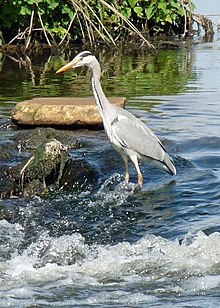User:Jokulhlaup/DraftEssex
| This is not a Wikipedia article: It is an individual user's work-in-progress page, and may be incomplete and/or unreliable. For guidance on developing this draft, see Wikipedia:So you made a userspace draft. Find sources: Google (books · news · scholar · free images · WP refs) · FENS · JSTOR · TWL |
Wildlife and ecology
[edit]Artificial changes along the Trent, due to navigation, farming, mineral extraction and drainage works, mean that much of the riparian landscape has been altered, reducing the amount of natural habitat. The river channel links the remaining, but fragmented wetland areas and nature reserves, providing a refuge for native and migrant species.[1][2][3] These includes wildfowl and wading birds that use the Trent valley as a migration corridor, with the river also being used as a wildlife route by mammals such as otters and non-native American mink.[3][4]

Additional nature conservation areas were created beside the river in the 20th century, when a number of disused gravel pits, were rehabilitated as nature reserves.[3][5] One of the most important of these is Attenborough Nature Reserve, a 226 hectares (560 acres) Site of Special Scientific Interest (SSSI) which is visited by wildfowl such as wigeon, teal and the red-breasted merganser. Wading birds such as oystercatcher and bittern have also been observed at the reserve; as have kingfishers, reed warblers and water rails.[6][7]
Other managed wetland sites along the river include Beckingham Marshes, Croxall Lakes, Drakelow, and Willington Gravel Pits. At Besthorpe near Newark, breeding pairs of Little Egrets and Grey Herons have been observed.[8][9][10][11]
The Trent valley also links together other SSSI and local nature reserves, which have varying habitats not only for birds, but also mammals, insects and fish, a good example is the tributary River Mease where the entire watercourse has been designated both as a SSSI and a European special area of conservation.[12]
One of the more unusual ecological sites is Pasturefields nature reserve near Hixon, an inland saltmarsh, which is a rare habitat for the UK. A vestige of the saline marshes created by the brine springs that seep from the groundwater of the Mercia mudstones, the reserve contains salt tolerant species normally found on the coast, such as sea plantain, arrowgrass and milkwort.[13]
Improvements in water quality and subsequent fish stocks, in combination with the ban on the use of certain persistent pesticides have meant that otters have now returned to the Trent system, having been absent as recently as the 1980s. A survey in 2003 showed a doubling in the number of sites where evidence, such as spraints and footprints of these elusive animals were found. They have also now been sighted at locations such as Wolseley, Willington, and Attenborough.[14][15][16][17]
The Trent acts as an important corridor both for migrating birds, such as wildfowl and waders, and as a wildlife route for rarer animals such as Otters (Lutra lutra), and water voles (Arvicola amphibius). In addition the river provides a link between the many, but fragmented nature reserves and different habitats along the valley. These reserves and habitats are important refuges for the flora and fauna that has been lost elsewhere along the river and in the wider valley, due to artificial changes such as drainage, farming, mineral workings and navigation. Although ironically many of the reserves have been created from disused gravel workings, that have been rehabilitated and improved for wildlife.
The Trent valley is an important corridor both for migrating birds, such as wildfowl and waders, and as a wildlife route for the movement of rarer mammals such as otters, water voles, and the non-native American mink a predator of the vole. The river provides a link between the many, but fragmented nature reserves and different habitats along its course, which are essential refuges for the native flora and fauna
Artificial changes such as drainage, farming, mineral workings and navigation works, mean that much of the natural riparian landscape has been altered. The reserves and wetland habitat along the river and in the wider valley are often all that remain of this original environment, although many of the reserves were created from disused gravel workings, which have been rehabilitated and improved for wildlife
References
- ^ "The OnTrent Initiative". wildlifetrust.org.uk. Retrieved 30 July 2014.
- ^ "River 'losing natural habitats'". BBC News. bbc.co.uk. Retrieved 10 July 2014.
- ^ a b c "Habitats". trentvale.co.uk. Retrieved 10 July 2014.
- ^ "Fifth Otter Survey" (PDF). Technical Report. environment agency. section 4.13. Retrieved 10 October 2014.
- ^ "Trent Holmes Living Landscape". Local Living Landscapes. wildlifetrust.org. Retrieved 10 July 2014.
- ^ "Attenborough Nature Reserve About". Nottinghamshire Wildlife Trust. Retrieved 18 August 2014.
- ^ "Wildlife Sightings at Attenborough Sightings for February 2010". Attenborough Nature Reserve. Nottinghamshire Wildlife Trust. Retrieved 18 August 2014.
- ^ "Drakelow". derbyshirewildlifetrust.org.uk. Retrieved 30 July 2014.
- ^ "Willington Gravel Pits". derbyshirewildlifetrust.org.uk. Retrieved 30 July 2014.
- ^ "BBC News". Little Egrets breed in Nottinghamshire for first time. bbc.co.uk. Retrieved 30 July 2014.
- ^ "Besthorpe Nature Reserve". trentvale.co.uk. Retrieved 19 July 2014.
- ^ "Trent Vale nature reserves". trentvale.co.uk. Retrieved 10 May 2014.
- ^ "Pasturefields". staffs-wildlifetrust.org.uk. Retrieved 30 July 2014.
- ^ "Otters in the Trent". BBC News. bbc.co.uk. Retrieved 10 July 2014.
- ^ "A River on the mend". BBC News. bbc.co.uk. Retrieved 10 July 2014.
- ^ "Photographer captures otter at Nottinghamshire reserve". BBC News. bbc.co.uk. Retrieved 10 July 2014.
- ^ "Great Places to See Otters" (PDF). Wildlife Trust. p. 2. Retrieved 18 August 2014.

